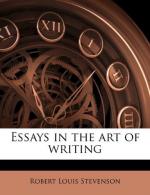It is, then, first of all, at this initial and decisive moment when execution is begun, and thenceforth only in a less degree, that the ideal and the real do indeed, like good and evil angels, contend for the direction of the work. Marble, paint, and language, the pen, the needle, and the brush, all have their grossnesses, their ineffable impotences, their hours, if I may so express myself, of insubordination. It is the work and it is a great part of the delight of any artist to contend with these unruly tools, and now by brute energy, now by witty expedient, to drive and coax them to effect his will. Given these means, so laughably inadequate, and given the interest, the intensity, and the multiplicity of the actual sensation whose effect he is to render with their aid, the artist has one main and necessary resource which he must, in every case and upon any theory, employ. He must, that is, suppress much and omit more. He must omit what is tedious or irrelevant, and suppress what is tedious and necessary. But such facts as, in regard to the main design, subserve a variety of purposes, he will perforce and eagerly retain. And it is the mark of the very highest order of creative art to be woven exclusively of such. There, any fact that is registered is contrived a double or a treble debt to pay, and is at once an ornament in its place, and a pillar in the main design. Nothing would find room in such a picture that did not serve, at once, to complete the composition, to accentuate the scheme of colour, to distinguish the planes of distance, and to strike the note of the selected sentiment; nothing would be allowed in such a story that did not, at the same time, expedite the progress of the fable, build up the characters, and strike home the




